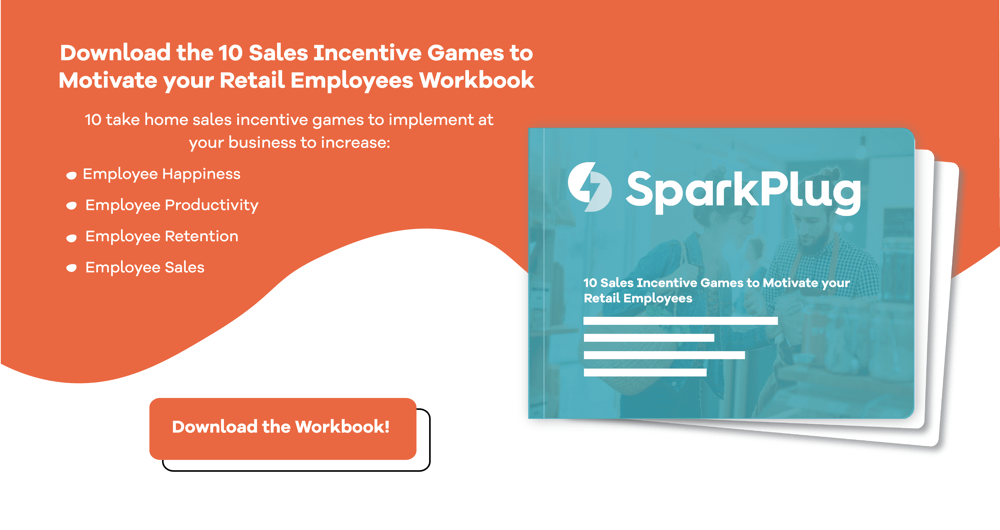Amid the current labor shortage, companies are offering higher compensation and benefits in a desperate bid to attract new talent and hold onto existing workers.
But a survey of 500 food service workers shows that rather than higher wages, they are more motivated by growing their skills, being the best server, and performance incentives.
A boost in pay is always nice, but tying an increase in compensation to performance is the more sustainable way to engage and motivate employees and keep them performing well and invested in the business for the long term.
Incentive tech in the restaurant and retail industries is making it easier to build reward programs that your employees are invested in. The type of programs that are easy to implement and offer instant rewards.
What is an employee incentive?
An incentive is a reward that motivates a person to behave in a certain way. In the workplace, incentives are used to motivate employees to perform better and be more productive. But incentives shouldn’t be used as bribes in exchange for the desired behavior.
They’re best used as a way to align the goals of the employee with those of the organization. For example, a competition between salespeople where the winner receives a cash bonus. The goal of the business to give better service and sell more product is now aligned with the employee’s motivation to sell more.
Intrinsic motivation means to be motivated to change ones behavior absent any external motivator, but instead because of the interest, pleasure, or learning derived from the activity itself. People paint as a hobby for relaxation, fun, and to become a better painter, for example.
Extrinsic motivation is performing an activity for some external reward or benefit. A child eats his vegetables so he can have dessert.
The trick is to find the balance between the two. Extrinsic motivation can be used to get the ball rolling until intrinsic motivation kicks in.
For example, an employee at a bike shop might at first be motivated to sell more bicycles because they want to win a prize. They learn all about the different bicycles, learn new sales tactics, and put more effort into talking to customers in order to get the prize.
But as they gain these new skills and get better results, they start to enjoy the process for its own sake. Getting better at helping customers find the perfect new ride becomes the goal as they move from extrinsic to intrinsic motivation naturally.
They’re not just motivated by the reward, but by the desire to give better service, learn more about the product, and outperform the competition. Used in this way, incentives get the employee engaged in their work which motivates them to perform better over the longer term.
How to incentivize employees in 6 steps
Technology can be used to launch an incentive program for amazing results, but there needs to be a strategy in place.
Think about the big picture first. Employees should feel agency, and in control of their success. They need clear goals and a vision of a future in the role. They need to feel they are heard and respected. Here’s how to make that happen.
1. Set clear goals
The road to success starts with knowing the destination. Setting concrete goals and working towards them is the best way to get motivated to do anything. Working with employees to align their goals with those of the business means everyone is pulling in the same direction.
Incentive software gives visibility to managers and employees so everyone can see what the goals are, how far along the road to success you are, and what you must to do achieve them. But before launching an incentive program, ensure everyone is working towards the same clear set of goals.
2. Encourage autonomy
Empowering employees to be responsible for their own success is a great way to move them over to intrinsic motivation. As they become more autonomous, they get a particular feeling of satisfaction from being responsible for their achievements.
It also means they can be held accountable when they don’t live up to their own expectations. Another powerful motivator to keep them on the road to success.
3. Provide training materials
As we’ve seen, progressing in a role and gaining new skills is one of the biggest motivators for frontline workers. Offering the right training resources is a way to get them engaged in learning. Again, extrinsic and intrinsic motivations come into play here.
They might start the training because they see that it will help them progress towards a sales goal. But hopefully, as they learn and improve, employees will seek out further training for learning’s sake and to make personal improvements.
It all starts with giving them easy access to engaging training materials.
4. Harness the power of gamification
One of the most powerful ways to get someone intrinsically motivated is to harness the natural desire to compete. Friendly competition is a strong primal motivator that brings people closer together and builds morale in a team.
Gamification is the process of taking a task and making it fun by turning it into a game. Those that perform better get closer to winning and they will therefore put more focus and effort into making sure they come out on top.
The idea is to push everyone to perform better as they compete to win. Incentivization technology tools allow you to easily create competitions with the results displayed on leaderboards for all to see and updated as sales are made.
In retail settings, the competition could simply be to sell the most units of a particular item. Or in a restaurant, it might be a competition to sell the most specials or have the fastest table turnover rate.
Competitions can be run between individuals and between competing teams and stores depending on the needs of the business. And the results can be used to improve future competitions and inform business decisions. The winner receives a cash reward or prize to motivate them to be the best.
5. Use vendor-sponsored incentives
Sales competitions don't need to cost the business a ton of money. Ideally, you want an excellent ROI from your competitions. That’s where vendor-sponsored incentives offer a host of benefits.
The way they work is the brand agrees to sponsor a competition to sell more of one of their products. They put up the prize which may take the form of product, cash, an experience, or some other desirable prize to motivate the employees to win.
In order to win the competition, employees are more likely to find out everything they can about the brand, get to know the product better, and push it harder on the sales floor. From the retailer’s perspective, salespeople are more engaged and knowledgable about the products but you don’t have to foot the bill for the competition.
6. Track engagement
With all of your incentives and competitions in place, the next step is to monitor the success of the campaigns so they can be honed, fine-tuned, and improved.
Employee incentive software allows you to set clear goals from the beginning, monitor team and individual performance in real-time, and track the progress and success of your competitions.
To gauge the success of a competition, you can generate ROI reports to see how much you spent, and how much new revenue was generated by each competition or incentive. With the data stored in the cloud, all of this is accessible from any location on a central dashboard.
Reap the compounding benefits of more engaged and motivated employees
Extrinsic motivation is a powerful force that can be used to move employees into their own intrinsic motivation for long-term engagement and success.
More engaged employees are happier in their work. Happier employees lead to better retention and performance. Which leads to better customer experience and better results for the business.
Incentivization tech has a host of features to keep your employees growing in their roles, learning all the time, and getting excited about sales competitions and performance incentives.
Learn more about how to engage and motivate your employees with sales incentives with our free guide: 10 Sales Incentive Games to Motivate Retail Employees.
.png?width=56&height=56&name=Jake-01%20(1).png)





